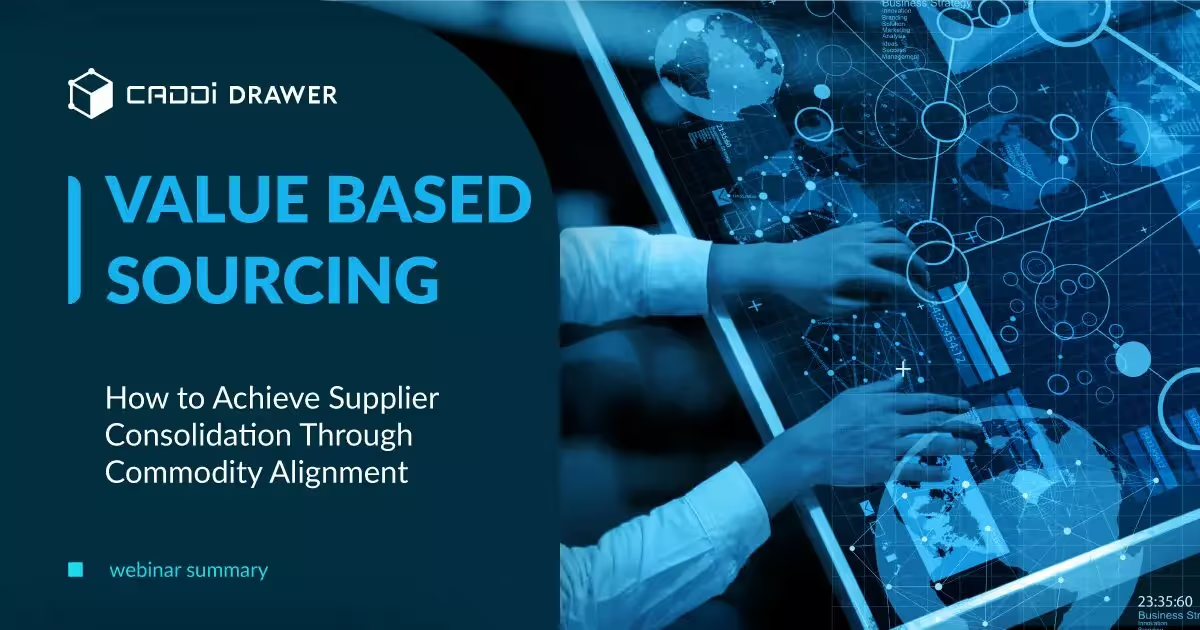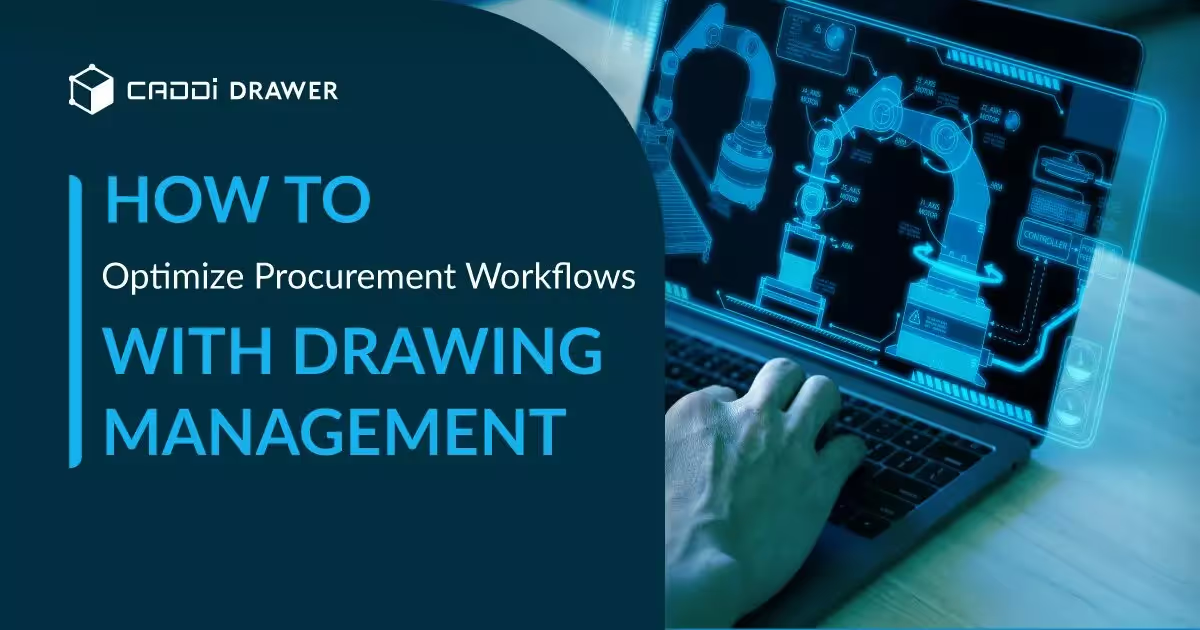Value Based Sourcing: How to Achieve Supplier Consolidation Through Commodity Alignment

CADDi recently hosted an insightful webinar on Value-Based Sourcing featuring two seasoned industry leaders: James Bos, former VP of Global Procurement at Yanfeng, and Chris Brown, VP of Sales at CADDi. The webinar provided a deep dive into the process of supplier consolidation through commodity alignment strategies.

Register to watch the full recording on-demand or keep reading to get a recap of the conversation.
[On-demand] Value-Based Sourcing: Reducing Costs Through Supplier Consolidation
Table of Contents

The Importance of Commodity Strategies
James emphasized that commodity strategies are critical for optimizing the supply base in a methodical way. Without a well-defined commodity strategy, companies often see an inflated supplier count, increased supplier risks, and even hindrance of innovative supplier solutions due to arbitrary reduction targets. In contrast, an effective commodity strategy enables:
- Significant reduction in supplier count, if initiating strategies for the first time
- Accounting for innovative suppliers
- Effective supplier risk management
“Commodity strategies enable a methodical way to optimize supplier count,” stated James. “If initiating commodity strategies for the first time, expect significant reduction in supplier count.”
The 7-Step Process for Supplier Consolidation
The webinar outlined a comprehensive 7-step process for achieving supplier consolidation:
- Commodity Strategy – defining process, cost elements, and market trends impacting the commodity
- Engineering Best Cost Design – collaboration between engineering and costing teams
- Manufacturing Input – alignment with manufacturing capability and footprint
- Supplier Factors – alignment with supplier capability, footprint, and performance
- Decision Point – optimization decisions based on overall best value
- Strategic Prioritization – developing the supplier optimization plan
- Execution Plan & Approval – ownership across stakeholders to assure alignment
We covered Step 1 in the previous webinar, so it was skipped here. For more details, please refer to the article below.
Transforming Procurement Through Value-Based Commodity Strategies: Insights from Experts
Optimizing Design Standards
In step 2, the focus is on determining the most cost-effective design, including Design for Manufacturing (DFM) principles. James provided examples of how this has yielded results in practice:
He also stressed the importance of working with engineering to optimize resin usage, enabling higher volume purchasing power.
Aligning with Manufacturing Requirements
Step 3 involves gaining input from the manufacturing team on their specific needs. Key considerations include:
- Proximity of suppliers to plants, especially in just-in-time environments
- Frequency of on-site supplier support needed and problem-solving capability
- Historical delivery and quality performance of suppliers
- Number of SKUs required by the plant
Evaluating Supplier Factors
In step 4, the focus shifts to assessing suppliers across several dimensions:
- Geographic location
- Overall performance
- Capability and risk factors
“It’s really important to understand where the supplier sits, and understand if you need to move quickly in potentially exiting a supplier,” advised James.
He also highlighted the importance of proactively seeking out new suppliers with unique technologies or skill sets that could improve the company’s overall performance.
Making Optimization Decisions
Step 5 is the critical decision point where companies must weigh various factors to determine the optimal supplier base. James outlined key considerations and potential outcomes:
- Placing suppliers “under evaluation” for improvements
- Immediately exiting or resourcing suppliers
- Phasing out suppliers post end-of-production
- Introducing new suppliers into the current supply base
When making these decisions, it’s important to account for:
- Transition costs vs. cost to balance out the supplier
- Testing and validation costs
- Obsolescence costs
- Payback timing
- Sustainability commitment timelines
- Required supplier development resource costs
Prioritizing and Executing
In step 6, suppliers are prioritized into categories such as Strategic (Grow or Maintain), Under Evaluation, Non-Strategic (Phase Out), and Exit. James shared a real-world example of the impact of this process:
The final step involves developing a detailed execution plan with clear actions, responsibilities, and timelines. Critically, this plan must be approved by and have ownership from leadership across procurement, engineering, operations, and other key functions.
“It’s not just checking a box,” said James. “It’s assuring that you have ownership throughout the organization when you get to the point of implementation.”
Leveraging Digital Tools
To support the supplier consolidation process, Chris demonstrated how CADDi’s software tool, Drawer, can help accelerate design standardization efforts. Drawer uses AI-powered shape recognition to quickly find similar parts across a company’s entire database of drawings.
6:09
“What we can see the CADDi Drawer system do immediately is find every single part, every single drawing that we’ve ever loaded into the system that contains the word ‘bearing’, for example – not just in the file name, but actually inside the assembly files,” explained Chris.
By identifying similar parts, engineers and sourcing teams can easily spot opportunities to consolidate designs and suppliers. Drawer also allows users to export detailed reports with pricing, lead time, quality, and risk data to inform decision making.
Measuring and Managing Suppliers
Throughout the webinar, James and Chris fielded various questions from the audience. One participant asked about measuring sustainability factors in supplier assessments.
James advised partnering with third-party services to assess suppliers’ environmental sustainability goals and progress. “It’s a pretty standard expectation, and there’s a number of commitments…that we’re following through with.”
Another attendee inquired about managing supplier relationships and potential financial risks over the long term. James emphasized the importance of regular business reviews with strategic suppliers:
> “We held, at minimum, annual business reviews with our strategic suppliers. To me, it’s a really important step that helps align strategies…between your company and the supply base.” – James Bos
Key Takeaways
The CADDi webinar provided a wealth of insights and practical advice for driving supplier consolidation through effective commodity management. Some of the key takeaways:
- Commodity strategies are essential for optimally reducing supplier count and managing risk
- Follow a robust, cross-functional process to align designs, manufacturing needs, and supplier capabilities
- Make data-driven decisions on supplier optimization, considering total costs and strategic priorities
- Secure broad organizational alignment and ownership of the execution plan
- Leverage digital tools to accelerate standardization and regularly measure supplier performance
By adopting these proven approaches, companies can build a streamlined, resilient, and high-performing supply base to power their success.
To learn more, please watch the full recording of our webinar by clicking the link below.
The Importance of Commodity Strategies
James emphasized that commodity strategies are critical for optimizing the supply base in a methodical way. Without a well-defined commodity strategy, companies often see an inflated supplier count, increased supplier risks, and even hindrance of innovative supplier solutions due to arbitrary reduction targets. In contrast, an effective commodity strategy enables:
- Significant reduction in supplier count, if initiating strategies for the first time
- Accounting for innovative suppliers
- Effective supplier risk management
“Commodity strategies enable a methodical way to optimize supplier count,” stated James. “If initiating commodity strategies for the first time, expect significant reduction in supplier count.”
The 7-Step Process for Supplier Consolidation
The webinar outlined a comprehensive 7-step process for achieving supplier consolidation:
- Commodity Strategy – defining process, cost elements, and market trends impacting the commodity
- Engineering Best Cost Design – collaboration between engineering and costing teams
- Manufacturing Input – alignment with manufacturing capability and footprint
- Supplier Factors – alignment with supplier capability, footprint, and performance
- Decision Point – optimization decisions based on overall best value
- Strategic Prioritization – developing the supplier optimization plan
- Execution Plan & Approval – ownership across stakeholders to assure alignment
We covered Step 1 in the previous webinar, so it was skipped here. For more details, please refer to the article below.
Transforming Procurement Through Value-Based Commodity Strategies: Insights from Experts
Optimizing Design Standards
In step 2, the focus is on determining the most cost-effective design, including Design for Manufacturing (DFM) principles. James provided examples of how this has yielded results in practice:
He also stressed the importance of working with engineering to optimize resin usage, enabling higher volume purchasing power.
Aligning with Manufacturing Requirements
Step 3 involves gaining input from the manufacturing team on their specific needs. Key considerations include:
- Proximity of suppliers to plants, especially in just-in-time environments
- Frequency of on-site supplier support needed and problem-solving capability
- Historical delivery and quality performance of suppliers
- Number of SKUs required by the plant
Evaluating Supplier Factors
In step 4, the focus shifts to assessing suppliers across several dimensions:
- Geographic location
- Overall performance
- Capability and risk factors
“It’s really important to understand where the supplier sits, and understand if you need to move quickly in potentially exiting a supplier,” advised James.
He also highlighted the importance of proactively seeking out new suppliers with unique technologies or skill sets that could improve the company’s overall performance.
Making Optimization Decisions
Step 5 is the critical decision point where companies must weigh various factors to determine the optimal supplier base. James outlined key considerations and potential outcomes:
- Placing suppliers “under evaluation” for improvements
- Immediately exiting or resourcing suppliers
- Phasing out suppliers post end-of-production
- Introducing new suppliers into the current supply base
When making these decisions, it’s important to account for:
- Transition costs vs. cost to balance out the supplier
- Testing and validation costs
- Obsolescence costs
- Payback timing
- Sustainability commitment timelines
- Required supplier development resource costs
Prioritizing and Executing
In step 6, suppliers are prioritized into categories such as Strategic (Grow or Maintain), Under Evaluation, Non-Strategic (Phase Out), and Exit. James shared a real-world example of the impact of this process:
The final step involves developing a detailed execution plan with clear actions, responsibilities, and timelines. Critically, this plan must be approved by and have ownership from leadership across procurement, engineering, operations, and other key functions.
“It’s not just checking a box,” said James. “It’s assuring that you have ownership throughout the organization when you get to the point of implementation.”
Leveraging Digital Tools
To support the supplier consolidation process, Chris demonstrated how CADDi’s software tool, Drawer, can help accelerate design standardization efforts. Drawer uses AI-powered shape recognition to quickly find similar parts across a company’s entire database of drawings.
6:09
“What we can see the CADDi Drawer system do immediately is find every single part, every single drawing that we’ve ever loaded into the system that contains the word ‘bearing’, for example – not just in the file name, but actually inside the assembly files,” explained Chris.
By identifying similar parts, engineers and sourcing teams can easily spot opportunities to consolidate designs and suppliers. Drawer also allows users to export detailed reports with pricing, lead time, quality, and risk data to inform decision making.
Measuring and Managing Suppliers
Throughout the webinar, James and Chris fielded various questions from the audience. One participant asked about measuring sustainability factors in supplier assessments.
James advised partnering with third-party services to assess suppliers’ environmental sustainability goals and progress. “It’s a pretty standard expectation, and there’s a number of commitments…that we’re following through with.”
Another attendee inquired about managing supplier relationships and potential financial risks over the long term. James emphasized the importance of regular business reviews with strategic suppliers:
> “We held, at minimum, annual business reviews with our strategic suppliers. To me, it’s a really important step that helps align strategies…between your company and the supply base.” – James Bos
Key Takeaways
The CADDi webinar provided a wealth of insights and practical advice for driving supplier consolidation through effective commodity management. Some of the key takeaways:
- Commodity strategies are essential for optimally reducing supplier count and managing risk
- Follow a robust, cross-functional process to align designs, manufacturing needs, and supplier capabilities
- Make data-driven decisions on supplier optimization, considering total costs and strategic priorities
- Secure broad organizational alignment and ownership of the execution plan
- Leverage digital tools to accelerate standardization and regularly measure supplier performance
By adopting these proven approaches, companies can build a streamlined, resilient, and high-performing supply base to power their success.
To learn more, please watch the full recording of our webinar by clicking the link below.
Ready to see CADDi Drawer in action? Get a personalized demo.
Subscribe to our Blog!
Related Resources












.svg)



.svg)
.svg)
.svg)


